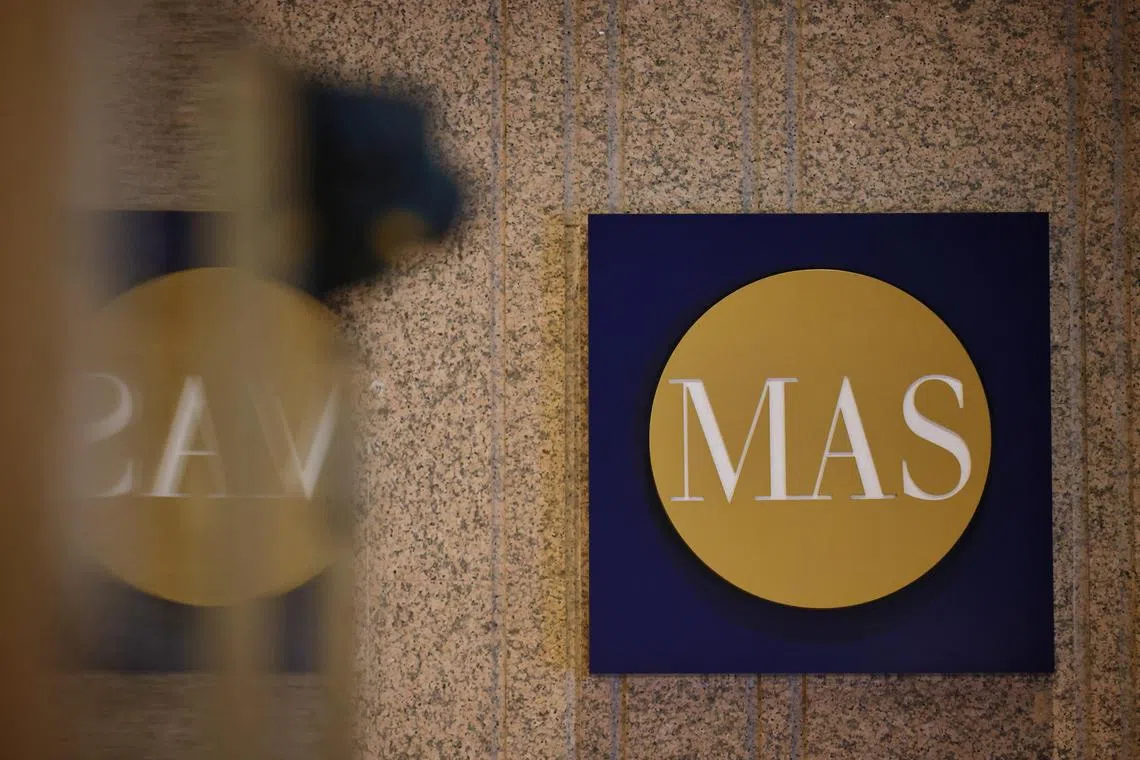MAS keeps Singdollar policy unchanged anticipating a ‘deeper’ economic slowdown
Sign up now: Get ST's newsletters delivered to your inbox

MAS said its five successive monetary policy tightening moves since October 2021 have tempered the momentum of price increases.
ST PHOTO: JASON QUAH
Follow topic:
SINGAPORE – In a surprise move, Singapore’s central bank hit the pause button in its monetary tightening policy, shifting its focus from ramping up the fight against inflation to defending the economy, which it said is facing the risk of a deeper slowdown.
The Monetary Authority of Singapore (MAS), which uses the Singapore dollar nominal effective exchange rate (S$Neer) as its main policy tool, said on Friday that it will maintain the current rate of currency appreciation – a stance that will continue to blunt the impact of rising import prices.
MAS’ pause is a surprise given that most private economists in recent private polls expected the central bank to go for a sixth round of policy tightening in the current cycle that started in October 2021.
However, with the economic outlook at risk, MAS did not seek a faster appreciation by further tightening monetary policy, as doing so could hurt the economy by making exports more expensive. Policymakers in Canada, India, Australia, South Korea, Malaysia and Indonesia have also opted in recent weeks to keep the monetary policy setting unchanged for similar reasons.
MAS said in its biannual monetary policy statement: “Singapore’s GDP (gross domestic product) growth is projected to be below trend this year. With intensifying risks to global growth, the domestic economic slowdown could be deeper than anticipated...
“MAS will therefore maintain the prevailing rate of appreciation of the S$Neer policy band. There will be no change to its width and the level at which it is centred. This policy stance will continue to reduce imported inflation and help curb domestic cost pressures.”
The Singapore dollar dropped as much as 0.5 per cent soon after the MAS policy announcement, but pared its fall as the US currency slid
Also on Friday, advance estimates showed that the Singapore economy grew just 0.1 per cent year on year in the first quarter
On a quarter-on-quarter seasonally adjusted basis, the economy shrank 0.7 per cent in the first three months of 2023, said the Ministry of Trade and Industry.
The ministry already expects Singapore’s GDP growth to step down to 0.5 per cent to 2.5 per cent in 2023, from 3.6 per cent in 2022.
Analysts believe the status quo on policy stance follows the weak economic data and MAS’ own assertion that core inflation will likely ease materially by end-2023.
Mr Edward Lee, chief economist for Asean and South Asia at Standard Chartered Bank, said a few factors suggest that the central bank is very comfortable with the wait-and-see mode.
“MAS sounded more confident that core inflation would fall,” he said. At the same time, the focus on the economic slowdown is clearer this time around, he added.
MAS on Friday kept its inflation forecasts unchanged, saying core inflation, which excludes accommodation and private transport costs, is expected to average 3.5 per cent to 4.5 per cent, while all-items or headline inflation is forecast to come in higher at 5.5 per cent to 6.5 per cent.
The authority said that while inflation is still elevated, its five successive monetary policy tightening moves since October 2021 have tempered the momentum of price increases.
“The effects of MAS’ monetary policy tightening are still working through the economy and should dampen inflation further,” it added.
MAS manages monetary policy by allowing the S$Neer to rise or fall versus currencies of its trading partners within an undisclosed band.
A stronger Singdollar dampens imported inflation, while domestic interest rates follow the lead of those set by major central banks.
The US Federal Reserve, European Central Bank and Bank of England have all raised their benchmark rates
At home, headline inflation, which represents the rate of price change for all items, moderated to an annual pace of 6.3 per cent in February,
However, both inflation figures are still way above the 1.5 per cent average for the decade before 2020.
Singapore’s growth outlook appears even more challenging than it looked at the start of 2023, as the economies of its major trading partners such as the US and European Union continue to slow, while the recovery in China is still in its early days.
Singapore’s non-oil domestic exports shrank 15.6 per cent in February,
MAS said the drag on global investment and manufacturing from tighter financial conditions will intensify in the quarters ahead. The boost to demand in most of the regional economies after their reopening in 2022 will also fade.
The central bank said that China’s rebound will largely be consumption-driven and oriented towards domestic services. Overall, growth in Singapore’s major trading partners will be slower in 2023, below the pace recorded in the previous two years, it added.
Ms Selena Ling, chief economist and head of treasury research and strategy at OCBC Bank, said Singapore’s first-quarter GDP data showed weakness in a range of sectors, from manufacturing to the wholesale trade, as well as in the finance and insurance sector.
“There is a risk if the domestic labour market softens further in the coming quarters amid the growing global headwinds, as this could start to weigh on consumer confidence,” said Ms Ling, who downgraded her full-year 2023 growth forecast for the economy from 1.8 per cent to 1.5 per cent.
MAS said core inflation will stay elevated in the next few months as accumulated business costs continue to feed through to consumer prices. However, it is expected to slow more discernibly in the second half of 2023, it added.
“Barring fresh shocks to global supply, Singapore’s imported inflation, which is already negative, should fall further alongside lower commodity prices and the stronger S$Neer. Domestic wage growth should also ease as labour demand moderates, especially in sectors more exposed to international trade and finance,” MAS said.
As to whether MAS might do a U-turn and ease monetary policy, Barclays Bank senior regional economist Brian Tan said the fight against inflation is not over yet
“While inflation expectations have moderated, we believe MAS will be reluctant to ease with price levels still high and another GST hike on the horizon,” he said, referring to the Government’s plans to raise the goods and services tax by another 1 percentage point in early 2024.
He said only a significant economic downturn that leads to visibly higher resident unemployment rates or a collapse in commodity prices could lead to a U-turn in policy settings.


